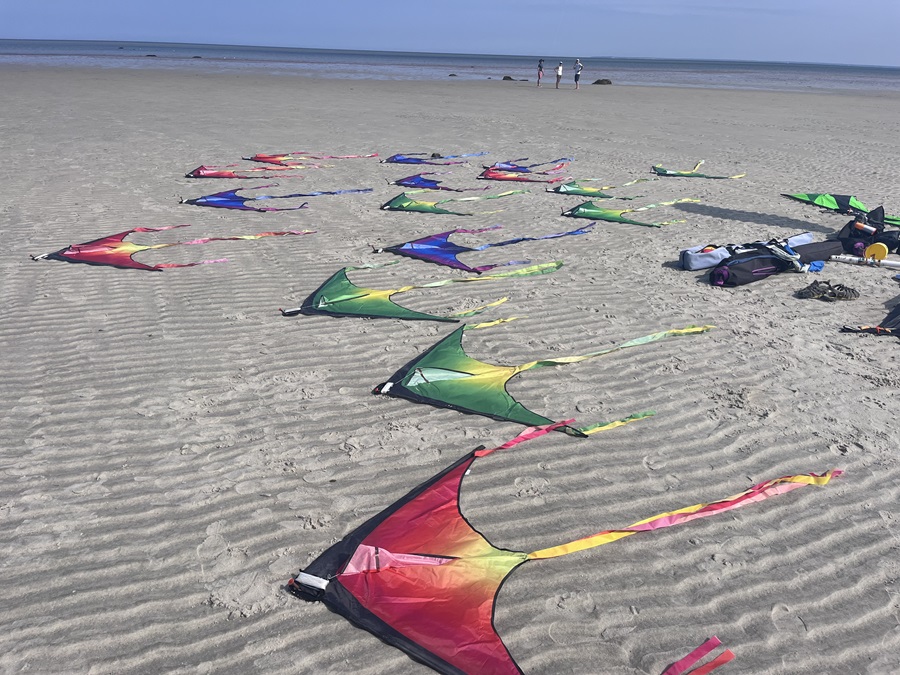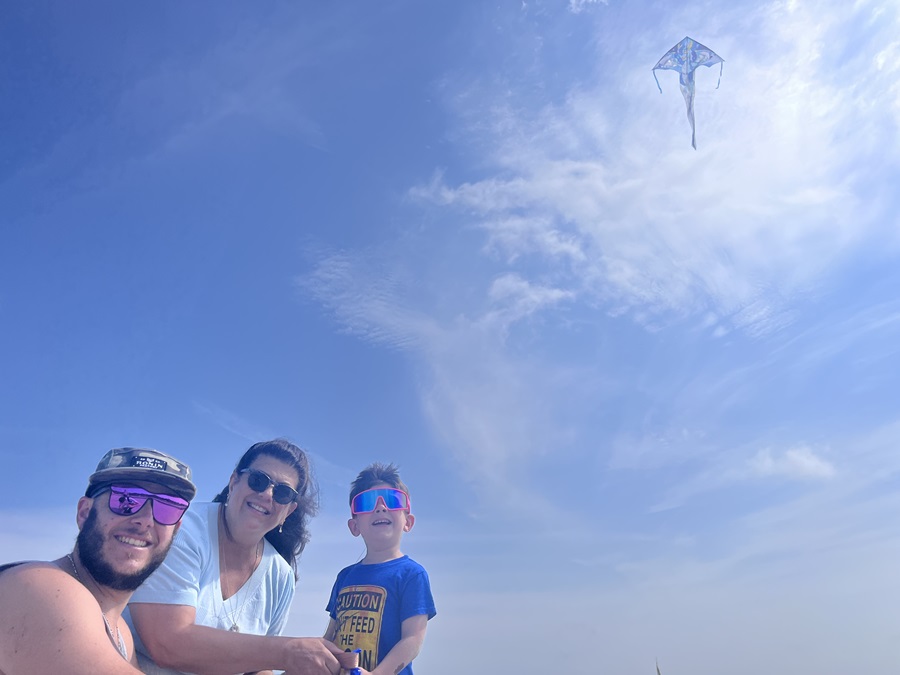EASTHAM — There is the prototypical single-line diamond kite suspended and stagnant above the flier’s head. And then there are sport kites, which carve the air, spin tight circles, and drop into free fall. That is what Keith Nemlich and Pete DeSandis, the owners of Outer Cape Kiting, want you to understand.
Nemlich and DeSandis are Outer Cape Cod’s premier (and perhaps only) sport kite fliers. Throughout the summer on warm days with a good breeze, they can be found flying dual-line sport kites in a delicate dance with the wind on Eastham’s bayside beaches.

Watching them fly is mesmerizing. DeSandis calmly calls out the signals as their kites cut to the right, turn upward, momentarily pause, and then slice back to the left. Beachgoers watch from their chairs and passersby gawk. But few actually approach the pair — despite a large flag reading “Fly with us!” stuck into the sand nearby.
“It’s really about trying to get more people flying sport kites, because this is such a great place to fly,” Nemlich says. “Our goal is to get more people to come out, get the lines in their hands, and get them flying.”
That is the paradox that confounds and inspires the two. With a consistent southwesterly wind and pristine flats, Outer Cape Cod is an ideal place to fly sport kites. Yet, for a variety of reasons including a lack of places selling high-quality kites and Massachusetts’s restrictive beach ownership laws, sport kiting remains the preserve of just a handful of enthusiasts.
When asked about who makes up the Outer Cape sport kiting community, Nemlich jokes, “You’re looking at them.”
“There’s probably more people like us out here,” says DeSandis, “but we’re not coordinated; we’re not working together on it.”
Sport kite fliers tend to be most populous where kite shops are close by. In Harwich, there is Dr. Gravity’s. Provincetown has one in front of the Provincetown Marina. But between those two, there is a dearth of suppliers.
Cheryl Costa, who bought the Kite Shop in Provincetown seven years ago, told the Independent that she stopped carrying the expensive kits because they do not sell.
“People just don’t want to invest in a good kite,” says Costa. “You used to see people flying here all the time, but not so much anymore.”
A cheap dual-line sport kite can cost as little as $30 online. But better-quality kites that are more durable, easier to control, and nimbler in the air can cost much more. Outer Cape Kiting sells a dual-line kite for $160 on its website, but sport kites can get as expensive as $500, according to Nemlich.

Nemlich and DeSandis have been flying kites together on Cape Cod for more than 30 years. For the first 20 years, they flew only during a couple of vacation weeks here. But about 10 years ago, they caught the kiting bug and made a more concerted effort to improve their skills.
Three summers ago, the duo, both of whom are now retired, started Outer Cape Kiting, which offers sport kiting lessons. An hour-long session is $45, but they offer free 20-minute ones, too.
Eventually, Nemlich and DeSandis would like to start a club where fliers can meet and practice together on a rotating set of beaches.
“It was really big in the mid-90s,” says Nemlich. “It slowly faded out of this country.”
“It’s a slow process,” says DeSandis.
The sport’s growth is also inhibited by Massachusetts’s tideland laws. In 1647, the Massachusetts Bay Colony extended beachfront property lines to the low-tide mark to encourage the building of more private wharfs, according to the Pioneer Institute, a Boston-based think tank.
The ordinance, which was adopted into Massachusetts law in 1851, has only three exceptions for public use of the intertidal zone: fishing, fowling, and navigation. The result is that beachfront property owners have more control over the coastal flats in Massachusetts than almost anywhere else in the country.
Cape and Islands state Sen. Julian Cyr introduced a bill to add “recreation” as another public-use exception in the legislature’s current session, which closes at the end of the month. The bill currently sits in the Senate Ways and Means Committee.
Cyr told the Independent that he thinks it is unlikely the bill will be passed this year but that it has a better chance of becoming law sometime in 2025 or 2026 when Gov. Maura Healey may focus on passing a large environmental package.
For now, Nemlich and DeSandis fly on beaches where they have permission from the homeowners or towns. DeSandis told the Independent that the town of Eastham asked them not to fly on its beaches, citing liability issues if someone were to run into the path of a dipping kite.
Incremental Progress
On Wednesday, July 10, Outer Cape Kiting brought 20 single-line kites and a dual-line kite to First Light Beach in Brewster for a “family fun fly,” the first of three events the company is putting on with the Brewster Recreation Dept. this summer. Nineteen of the 20 spots on the list were filled, but only about half a dozen people showed up. Several others who had not signed up joined the event, too.

Jennifer Hritz, who came with her daughter Mackenzie, told the Independent that her family had bought dollarstore kites in the past but had been discouraged when they could barely get them off the ground.
“Now that I know what’s involved and that if you spend a little more it’ll actually work, then it’s worth it,” said Hritz, watching her daughter launch the dual-line sport kite for the first time while being coached by DeSandis.
Carol Marash told the Independent that she has been visiting Cape Cod and flying kites on the flats for about 30 years. On Wednesday, three generations of the Marash family — Carol, her son Mike, and her grandson Jack — flew kites on the flats.
“I wish I were up there — I dream of flying,” said Marash, watching her grandson run with his new dragon kite. “It’s just fun to watch them control something that’s flying.”
